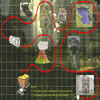Rotation Navigation TN
Teacher Notes

I find that some students struggle for a long time with the idea of a centre of rotation, and that its position is defined using coordinates. This activity is a great example of how software allows students to develop an understanding of this concept starting from their own, innate, intuition thanks to the quick experimentation that technology allows. The software interfaces then create a need for a more precise definition of the rotations. Both Geogebra and Autograph's interfaces can continually display the coordinates of the centre of rotation (and how these change as the centre changes) and require the student to input an angle and a direction.
For both the "Around the World" and "Jungle Obstacle" activities students should find there are a wide range of possible solutions. This opens up a great opportunity for discussions of the strategies used by different students.
What to Expect?
For the "Around the World" activity students started off using their intuition and trial and error. However, going round the class I soon noticed that one of the students was only using 180° turns. She had developed a strategy of drawing a line from her starting point to where she wanted to go, measuring it, finding the mid-point and using this as her centre of rotation. This provided a great discussion opportunity. The rest of the class benefited from seeing this girl's methods and she benefited when she saw that 180° rotations weren't the only solutions possible!
This lead to a discussion on how many different solutions did the class think were possible for any one stage of a journey? This developed into a challenge, for students who finished early, to try and find as many different centres or rotation and angles of rotation as possible for any given stage on the "around the world" trip.
I took the work of this Y7 class and presented it to my Y10 higher class (able 14-15yr olds). The question I asked them was:
"How many different centres of rotation provide an adequate solution for any given stage between two places?"
"Can you develop a general method for finding a variety of rotation solutions to take you between any two places?"
This also provides a good introduction to Locii or arc lengths and sectors - is the angle the same from each centre of rotation? If not, can you explain why not and how you could calculate what the angle of rotation will be (use of arc length and radii measurements)?
The video below shows a quick overview of the sorts of questions and general methods that can arise.
The "Jungle Obstacle" activity raises the same questions and more:
- For any centre of rotation is there an angle that will produce a solution?
- For any given centre of rotation, how many solutions will there be that lie on the red line? Can you demonstrate how to find these solutions? (e.g. show the intersections of the red path with a circle drawn using the centre of rotation as its centre)
- For any given angle, is their a centre of rotation that will provide a solution that lies on the red path? (yes, an infinite number of solutions! Can students explain why?).
Technical considerations
It is worth the teacher spending some time getting used to using the software and manipulations required for this task. The Geogebra software can be quite sensitive about whether or not you have correctly selected the object and centre of rotation - be prepared to help students with this.

